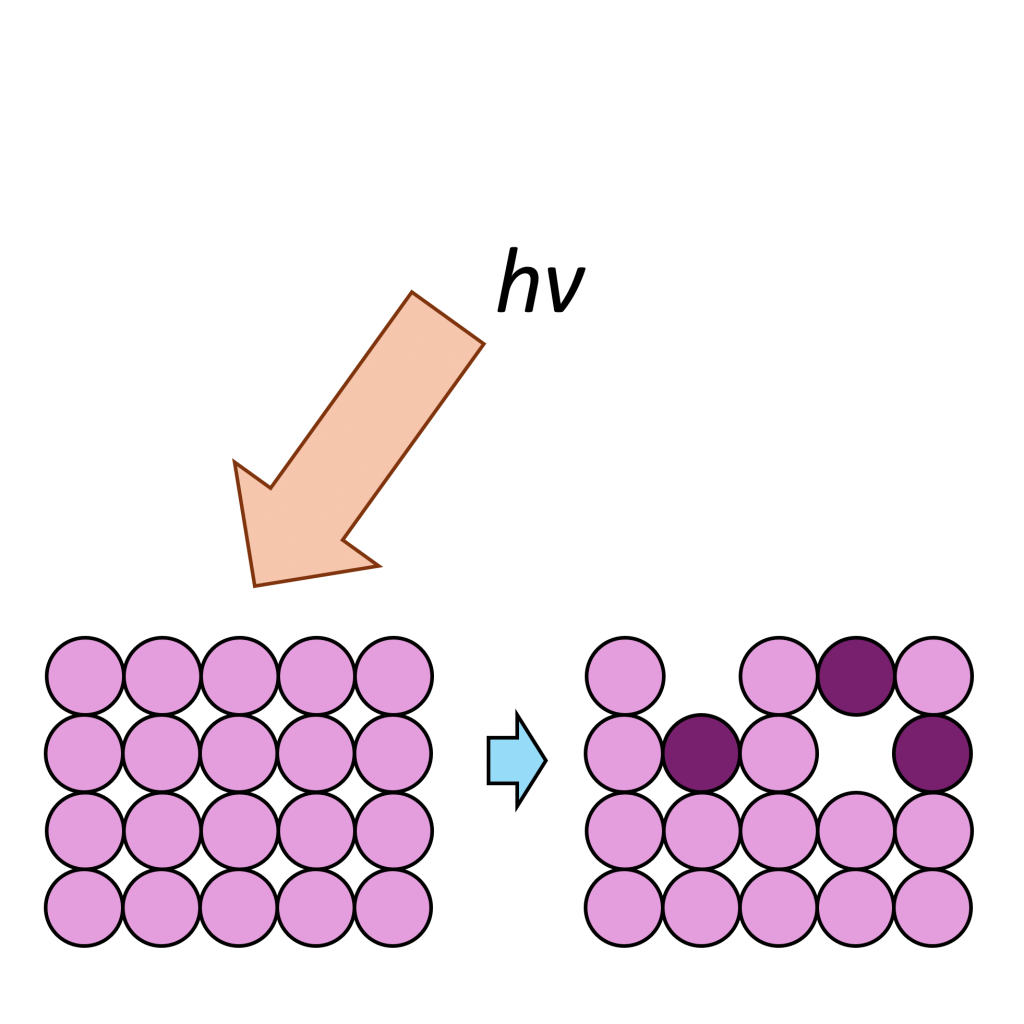
Titanium
Doublet Separations – Titanium exhibits different doublet separations based on oxidation state.
- Ti 2p (metal): 6.1 eV
- Ti 2p (nitride): 6.0 eV
Ti 2p (oxide): 5.7 eV
The Energies Listed are Binding Energies!
- Ti 2s: 566 eV
- Ti 2p: 454 eV
- Ti 3s: 59 eV
- Ti 3p: 34 eV
The Energies Listed are Binding Energies!
Ti is primarily analyzed via the 1s orbital
- Er 4s (449 eV)
- In 3d (451 eV)
- Ru 3p (461 eV)
- Ru 3p (461 eV)
- Bi 4d (464 eV)
- Ta 4p (465 eV)
Energies listed are Kinetic Energies!
Ti LMM: ~ 410 eV
The Energies Listed are Binding Energies!
| Species | EB / eV | Doublet Separation / eV | Charge Ref | Ref |
| Ti metal | 454 | 6.1 | Au 4f (84 eV) | 3 |
| TiN | 455.3 | 6 | Au 4f (84 eV) | 3 |
| TiO2 | 459.3 | 5.7 | Au 4f (84 eV) | 4 |
| Ti2O3 (Ti3+) | 456.6 | C 1s (284.6 eV) | 5 | |
| TiO (Ti2+) | 454.4 | C 1s (284.6 eV) | 5 | |
| TiS2 | 456 | C 1s (284.6 eV) | 5 | |
| TiS3 | 455.9 | C 1s (284.6 eV) | 5 |
Table 1: Typical binding energies for various common Ti species
TiO2 is readily reduced by Ar+ sputtering, forming suboxides.
XPS of titanium is typically performed on the 2p region. Unlike later first row TMs Ti 2p does not undergo multiplet splittings in it’s compounds, due to a lack of unpaired d-electrons. Ti 2p does, however, feature asymmetric peak broadening due to a Coster-Kronig transition and so care should be taken when peak fitting. The Ti 2p1/2 may be fit with a FWHM wider than that of the Ti 2p3/2.
Ti 2p peaks are mostly uncomplicated doublets (Figure 1) with a separation of around 6 eV (see table 1).
 Figure 1: TiO2 Ti 2p XPS(1)
Figure 1: TiO2 Ti 2p XPS(1)
The exception to this is titanium nitride (TiN) which exhibits a complex structure including shake-up peaks, bulk and surface plasmons.(2)
Not available
Not available
- Kumar, S., et al. (2017). “P25@ CoAl layered double hydroxide heterojunction nanocomposites for CO2 photocatalytic reduction.” Applied Catalysis B: Environmental 209: 394-404. Read it online here.
- Jaeger, D. and J. Patscheider (2013). “Single crystalline oxygen-free titanium nitride by XPS.” Surface Science Spectra 20(1): 1-8. Read it online here.
- Badrinarayanan, S., et al. (1989). “XPS studies of nitrogen ion implanted zirconium and titanium.” Journal of Electron Spectroscopy and Related Phenomena 49(3): 303-309. Read it online here.
- Diebold, U. and T. Madey (1996). “TiO2 by XPS.” Surface Science Spectra 4(3): 227-231. Read it online here.
- Gonbeau, D., et al. (1991). “XPS study of thin films of titanium oxysulfides.” Surface science 254(1-3): 81-89. Read it online here.
- Biesinger, Mark C., et al. “Resolving surface chemical states in XPS analysis of first row transition metals, oxides and hydroxides: Sc, Ti, V, Cu and Zn.” Applied surface science 257.3 (2010): 887-898. Read it online here.
